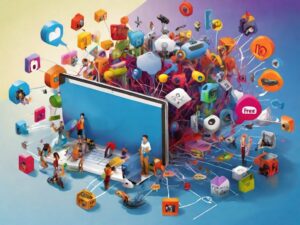What Makes Deep Learning The Game-Changer In The World Of Emerging Technologies?
Deep learning, a subset of artificial intelligence, has revolutionized various industries due to its ability to extract intricate patterns from large sets of data. This sophisticated technology has proven to be highly impactful in fields like healthcare, finance, and marketing, where it enables more accurate predictions and personalized recommendations. The powerful algorithms used in deep learning models can continuously learn and improve, making them invaluable in tackling complex problems that were once deemed insurmountable. Understanding why deep learning stands out as the game-changer in the world of emerging technologies can provide insights into how it will shape the future of innovation and decision-making processes.
Understanding Deep Learning
Fundamental Concepts and Architecture
One of the fundamental concepts of deep learning is the use of artificial neural networks that are inspired by the structure and function of the human brain. These neural networks are composed of layers of interconnected nodes, or artificial neurons, that process information and extract patterns from the data. The architecture of deep learning models typically consists of an input layer, one or more hidden layers, and an output layer.
Deep learning models learn to perform tasks by adjusting the weights of the connections between the neurons based on the input data. This process, known as backpropagation, allows the neural network to improve its performance over time through training on large amounts of labeled data.
Comparing Deep Learning with Traditional Machine Learning
| Deep Learning | Traditional Machine Learning |
| Uses neural networks with multiple layers for data processing | Relies on algorithms to process data |
| Requires large amounts of data for training | Can work well with smaller datasets |
The ability of deep learning to automatically learn representations from data makes it well-suited for tasks such as image and speech recognition, natural language processing, and autonomous driving. While traditional machine learning algorithms require feature engineering and manual selection of relevant features, deep learning models can extract features automatically from the raw data.
Comparing Deep Learning with Traditional Machine Learning
| Deep Learning | Traditional Machine Learning |
| Requires more computational power | Less computationally intensive |
| Highly effective for complex tasks | May be more interpretable for simpler tasks |
Applications of Deep Learning
Advances in Computer Vision
The field of computer vision has been revolutionized by the advancements in deep learning. One of the key breakthroughs is the ability of deep learning models to accurately recognize and classify objects in images and videos. This has led to significant improvements in tasks such as object detection, image segmentation, and facial recognition.
Additionally, deep learning has enabled the development of systems that can understand and interpret the content of images at a level comparable to human understanding. This has paved the way for applications in autonomous vehicles, medical image analysis, and visual search engines.
Breakthroughs in Natural Language Processing
Computer systems are now able to understand and generate human language with a level of accuracy and fluency that was previously thought impossible. This has been made possible by the advances in deep learning algorithms for natural language processing. These algorithms can now power chatbots, language translation services, and text summarization tools with remarkable precision.
One exciting development in natural language processing is the ability of deep learning models to capture the context and meaning of words within sentences. This has significantly improved the quality of machine-generated text and has opened up new possibilities in areas such as sentiment analysis and speech recognition.
Furthermore, the integration of deep learning with natural language processing has the potential to revolutionize the way we interact with technology. By enabling more intuitive and natural communication between humans and machines, this advancement could lead to a more seamless and personalized user experience across various applications and industries.
Challenges and Solutions
Data Requirements and Computational Costs
For any deep learning application to be successful, it requires a massive amount of data for training, validation, and testing. This poses a significant challenge as collecting and labeling large datasets can be time-consuming and expensive. Additionally, the computational power needed to process this data is immense, leading to high computational costs.
Solutions: To address these challenges, researchers are exploring techniques such as transfer learning, which allows models to leverage pre-trained weights from similar tasks, reducing the need for extensive labeled data. Furthermore, advancements in hardware, such as GPUs and TPUs, have significantly accelerated the training process, making it more efficient and cost-effective.
Overcoming the Black Box Nature of Deep Learning Models
Black box nature of deep learning models refers to the inability to interpret how the model arrives at a particular prediction. This lack of transparency can be a significant obstacle, especially in critical applications where understanding the reasoning behind decisions is crucial.
Solutions: Researchers are actively working on developing methods to interpret and explain deep learning models’ decisions. Techniques such as LIME (Local Interpretable Model-agnostic Explanations) and SHAP (Shapley Additive Explanations) provide insights into model predictions by generating interpretable explanations for individual predictions.
Future of Deep Learning
Integrating with Other Emerging Technologies
With the rapid advancements in technology, deep learning is set to revolutionize various industries by integrating with other emerging technologies. From autonomous vehicles to healthcare, the collaboration of deep learning with Internet of Things (IoT), blockchain, and augmented reality (AR) is paving the way for smarter solutions and enhanced user experiences.
This integration enables deep learning algorithms to process vast amounts of data from connected devices, improving decision-making processes and personalized services. For example, in the healthcare sector, deep learning combined with IoT devices can analyze patient data in real-time, leading to more accurate diagnostics and personalized treatment plans.
Potential Impacts on Society and Industry
Society as we know it is on the brink of monumental changes due to the impact of deep learning on various industries. From reshaping the workforce with automation to enhancing convenience with predictive algorithms, the implications are vast and transformative. Advancements in deep learning have the potential to streamline processes, reduce human error, and ultimately improve the quality of products and services across industries.
Technologies such as autonomous systems, predictive analytics, and natural language processing are being enhanced by deep learning, leading to more efficient operations and innovative solutions. However, as with any powerful technology, it is crucial to address ethical considerations and potential risks to ensure a responsible integration of deep learning in society and industry.

Final Words
To wrap up, deep learning stands out as a game-changer in the world of emerging technologies due to its unparalleled ability to analyze vast amounts of data, recognize patterns, and make predictions with remarkable accuracy. The deep neural networks mimic the human brain’s way of learning and problem-solving, opening up endless possibilities for innovation and advancement in various fields such as healthcare, finance, autonomous vehicles, and more. As we continue to delve deeper into the realm of deep learning, we can expect to witness groundbreaking developments that have the potential to revolutionize industries and enhance human capabilities beyond imagination.
FAQ
Q: What is deep learning and why is it a game-changer in the world of emerging technologies?
A: Deep learning is a subset of artificial intelligence that involves training neural networks with vast amounts of data to recognize patterns and make decisions with minimal human intervention. It is a game-changer because it enables machines to learn complex tasks and solve problems that were previously thought to be beyond the capabilities of computers.
Q: How does deep learning differ from traditional machine learning algorithms?
A: Deep learning uses deep neural networks with multiple layers to extract features from data, while traditional machine learning algorithms typically require manual feature extraction. Deep learning algorithms can automatically learn hierarchical representations of data, making them more powerful for tasks like image and speech recognition.
Q: What are some real-world applications of deep learning technology?
A: Deep learning is being used in various industries, including healthcare (diagnosis of diseases from medical images), finance (fraud detection), automotive (autonomous driving), and marketing (personalized recommendations). It is also used in natural language processing tasks like language translation and sentiment analysis.
Q: What are the challenges associated with implementing deep learning systems?
A: Some of the challenges of implementing deep learning systems include the need for large amounts of labeled training data, the computational resources required to train deep neural networks, and the interpretability of black-box models. There are also concerns around the ethical implications of using AI in decision-making processes.
Q: How can businesses leverage deep learning to gain a competitive advantage?
A: By harnessing the power of deep learning, businesses can automate repetitive tasks, improve the accuracy of predictions, and unlock valuable insights from their data. This can lead to cost savings, enhanced customer experiences, and the development of innovative products and services that set them apart from competitors.
![]()












